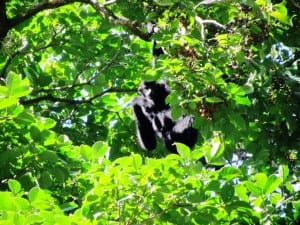Journey to find and save the world’s rarest primates
By ucfbceh, on 1 June 2011
The ‘Journey to find and save the world’s rarest primates’ event provided an opportunity for people from all backgrounds to come together and celebrate the International Day for Biological Diversity, as well as the International Year of Forests. Organised by gibbonologist Helen Chatterjee, UCL Genetics, Evolution and the Environment, the evening sought to raise the profile of the Hainan gibbon, the world’s rarest primate. The Save the Gibbons website provides details on the problem and ways which we can all help.
The evening was extremely thought provoking and provided a means to highlight the crises facing many relatively unknown species. With several people within the audience admitting to not knowing that the gibbon, a small ape living in China, was the most endangered ape, Helen Thirlway the Director at International Primate Protection League (UK) reported that there are still many people who do not even know what a gibbon is. Helen Thirlway was accompanied by fellow gibbonologists Jessica Bryant from UCL Genetics, Evolution and Sam Turvey from the Zoological Society of London. The evening was made possible through support from the UCL Public Engagement Unit under the Beacons for Public Engagement programme – funded by the UK funding councils, Research Councils UK and the Wellcome Trust.
The talks were kicked off by an overview of the probable extinction of the Yangtze River Dolphin. Although obviously not a primate, this talk essentially provided a case study with regards to what happens when not enough is done to help a species. Sam Turvey took us on a poignant journey of the story of this fresh water dolphin, a tale of destructive fishing practices, habitat loss and hunting. A sadly familiar story, which has lead to a decline from 400 animals in the late 1970’s to possibly only 13 individuals in the 1990’s. The inclusion of the last photograph of this species, taken in 2002, provided a moment of realisation that since 2002, no Yangtze river dolphins have been seen. Attempts were made for both in situ conservation, conserving animals in their habitat, and ex situ conservation in closely managed semi natural reserves; unfortunately these schemes proved unsuccessful.
The important question raised was, were the failures seen in the preservation of this species as a whole specific to this project, or a likely outcome for many such projects? I hope that the success in projects such as the Giant Panda in China may indicate that other critically endangered animals do have a future, provided that the necessary input of money and time and a sense of urgency are felt by those in the position to make the most difference.
When we then turn to the story of the critically endangered Hainan gibbon, with a total global population of only 23 individuals we have to ask; could we be approaching the first ape extinction in recent times? This was a crucially important point raised by Jessica Bryant, followed by a plea for action, given that time is running out. Jessica showed us a great set of clips from her field work which is undertaken in collaboration with the Hong Kong based NGO Kadoorie Farm and Botanic Gardens and Bawangling National Nature Reserve, home to the few remaining Hainan gibbons. Hearing the melodic sounds these gibbons make and seeing footage of them in the forest canopy allowed us to see the beautiful animals, if only fleetingly, without the need to eat congee for breakfast at 4am followed by a mammoth game of chase the gibbon; challenges faced by Jessica and her colleagues each day they work in the jungle. The fact that so little is know about this species of ape means that an understanding of why the population size does not appear to be increasing beyond a population of between 13 – 25 individuals makes knowing where to start with the conservation of these animals difficult. Could providing a larger habitat space be enough to increase their numbers, or is it more complex than this? My feeling is that there are many aspects that need to be addressed together in order to help this species. The donations of money and time to the cause are the only way to continue taking steps forward.
Organisations such as the International Primate Protection League provide a crucial step forward for primates in order to raise the awareness of the general public, and instill the importance of conservation upon the authorities involved. The IPPL works to increase the awareness of the need to protect the world’s primates. Money raised so far, has been presented to projects to be used in the protection of primates in their native country of China. Media coverage has been generated with the help of several celebrity faces including Bill Oddie and a re-release of the Goodies ‘Funky Gibbon’ song. However, Helen tells us that she still gets a blank look on occasion when she mentions the word gibbon, indicating that still more work is needed to raise the profile of these small apes. Let’s hope that this evening has gone some way to doing that.
Please visit Save the Gibbon www.savethegibbon.org where you can help the cause!
The evening concluded with an interactive Question and Answer session and drinks in the newly re-housed Grant Museum of Zoology, which provided an opportunity for the 100 strong audience to quiz the speakers:
Q: If conservation had been successful in the Tian’e Zhou oxbow lake,would the Yangtze River ever recover enough for reintroduction of the river dolphin?
A: In the short term no, but regeneration of a river is possible as seen with the Thames. It could have happened.
Q: If the 23 remaining Hainan gibbons do breed to create a larger population, would the inbred nature of the population create an indelible stain on the species, or can it still be worked with?
A: There is not much point in speculating until we really know. In order to look at inbreeding, historical genetic diversity must be compared and the genetic diversity of the modern group must be understood. This can then be compared to the genetic diversity of other species to see if a population from such a small group has an effect on the health of the species.
Q: There are acres of new habitat for the Hainan gibbon, how was this done?
A: The concept of increased habitat produced by the money we have raised and injected into the project are currently hypothetical. This money has only recently been transferred to the projects, but this is what could be done with the money we have raised so far. The website will be updated with what has been achieved. In Hainan, the replacement of plantations with forest does occur although it is a long process. Planting of native fig trees, a food source for the gibbons could provide an edge for breeding in Hainan.
Q: I am struck by the comparison between gibbons and gorillas. A key strategy implemented for gorillas was the introduction of Gorilla tourism. Could we sell ‘You have saved a species’ as a selling point?
A: China does promote Hainan as a holiday destination. It’s possible
Q: Could voluntourism be used to help monitor the last 23 Hainan gibbons?
A: I am not sure, to be honest when tracking, the team knows the area and does most of the work. A larger team doesn’t help. We also do not understand the affect us tracking the gibbons has on the group, so a better knowledge is needed before this could be possible.
3 Responses to “Journey to find and save the world’s rarest primates”
- 1
-
2
UCL Museums & Collections Blog » Blog Archive » Conservation in China? It’s hard to be hopeful wrote on 14 December 2011:

[…] Jessica Bryant undertaking a PhD on its conservation. We ran an event about it last year – write up here). I suppose the difference is hardly statistically significant, but the population has since risen […]
-
3
The world's rarest primate wrote on 16 May 2014:

[…] This past March, an emergency meeting was convened in Hainan to assess the ability of this species to survive and to work out a plan to ensure its longevity, if possible. An increase in monitoring of the remaining individuals will likely be crucial to the success of these efforts, although there is much we still do not know about the needs of this elusive species. […]
 Close
Close





I hope this helps to raise awareness of the plight of the Hainan gibbon. For those that were not lucky enough to attend the talk this gives a good synopsis.